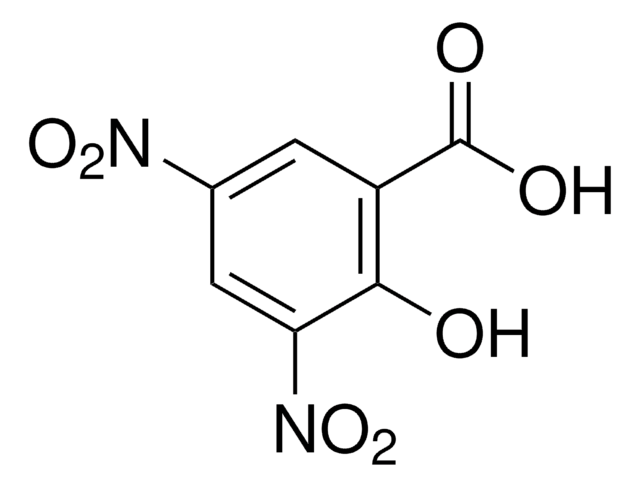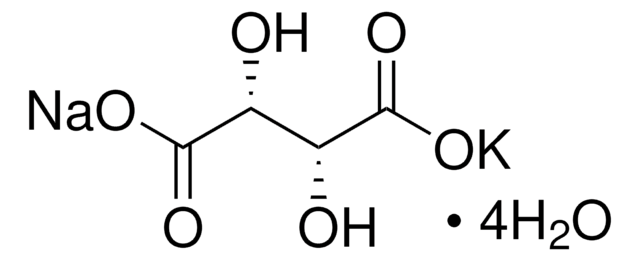S2004
Starch from potato
Soluble
Autenticatiper visualizzare i prezzi riservati alla tua organizzazione & contrattuali
About This Item
Formula condensata:
(C6H10O5)n
Numero CAS:
Numero CE:
Numero MDL:
Codice UNSPSC:
12352201
ID PubChem:
NACRES:
NA.21
Prodotti consigliati
Origine biologica
potato
Livello qualitativo
Stato
powder
Colore
white
Intervallo di pH utile
5.0-7.5 (2% in water)
Temperatura di conservazione
room temp
Cerchi prodotti simili? Visita Guida al confronto tra prodotti
Categorie correlate
Descrizione generale
Starch is a carbohydrate reserve in plants and a major source of energy for humans. In plants, starch is found in chloroplasts of leaf and in the amyloplasts of tuber and seeds. Structurally, starch consists of two major polysaccharides, namely amylose and amylopectin. Both consists of chains of -(1,4)-linked D-glucose residues interconnected through -(1,6)-glycosidic linkages. Potato starch is superior to others, functionally, because of its low lipid level. Nutritional composition of starch comprises of rapidly digestible starch, slowly digestible starch, and resistant starch (RS). Amylases are the starch degrading enzymes. Starch digestibility affects the blood glucose levels and is controlled by factors like carbohydrate contents of foods, nutritional composition of starch and cooking foods. Inhibition of pancreatic amylase is of therapeutic importance for delaying starch digestion, to prevent postprandial hyperglycemia. Food industries use starch as thickening agent.
Applicazioni
Starch from potato has been used as a substrate for α-amylase inhibition assay, by use of raw and cooked food samples and aerial parts of Trichosanthes cucumerina Linn, as a substrate to determine SusG activity, in animal gut microbiota activity using DNSA assay.
Altre note
To gain a comprehensive understanding of our extensive range of Polysaccharides for your research, we encourage you to visit our Carbohydrates Category page.
Codice della classe di stoccaggio
11 - Combustible Solids
Classe di pericolosità dell'acqua (WGK)
nwg
Punto d’infiammabilità (°F)
Not applicable
Punto d’infiammabilità (°C)
Not applicable
Scegli una delle versioni più recenti:
Possiedi già questo prodotto?
I documenti relativi ai prodotti acquistati recentemente sono disponibili nell’Archivio dei documenti.
I clienti hanno visto anche
Starch: as simple as A, B, C?
Wang TL, et al.
Journal of Experimental Botany, 49(320), 481-502 (1998)
Comparative Analysis of Nutritional and Bioactive Properties of Aerial Parts of Snake Gourd (Trichosanthes cucumerina Linn.)
Liyanage R, et al.
International journal of food science, 2016 (2016)
Extraction and Optimization of Potato Starch and Its Application as a Stabilizer in Yogurt Manufacturing
Altemimin AB
Foods (Basel, Switzerland), 7(2), 14-14 (2018)
Amylases: Characteristics and industrial applications
Saini R, et al.
Journal of Pharmacognosy and Phytochemistry, 6(4), 1865-1871 (2017)
Understanding starch structure: Recent progress
Bertoft E
Agronomy, 7(3), 56-56 (2017)
Protocolli
Enzymatic Assay of Pectinase
This procedure may be used for the determination of Amyloglucosidase activity using starch as the substrate.
Il team dei nostri ricercatori vanta grande esperienza in tutte le aree della ricerca quali Life Science, scienza dei materiali, sintesi chimica, cromatografia, discipline analitiche, ecc..
Contatta l'Assistenza Tecnica.



